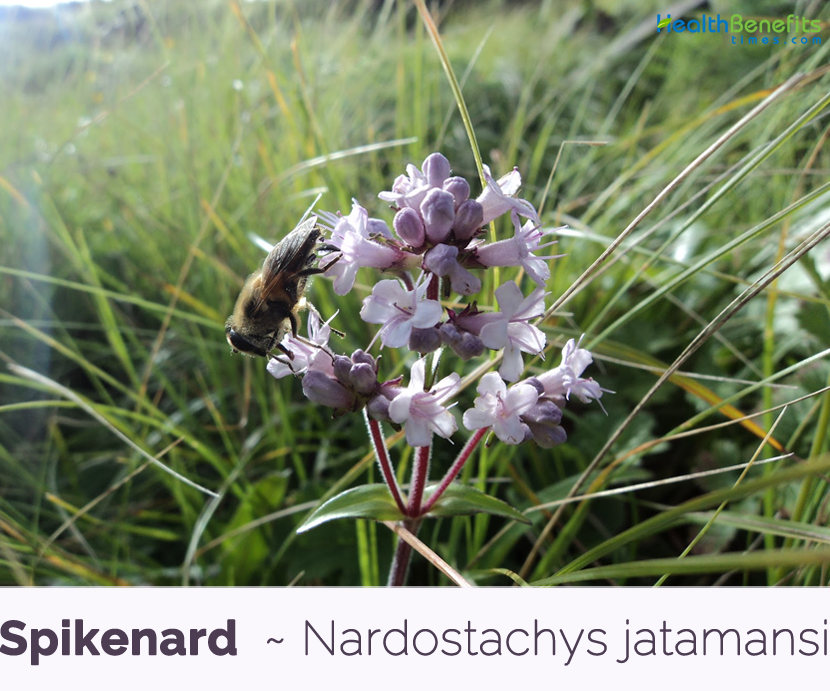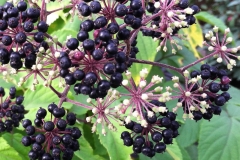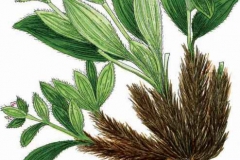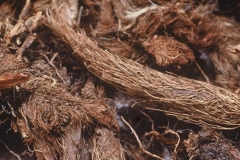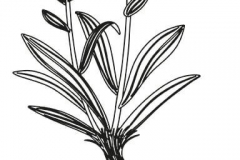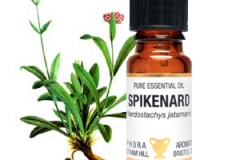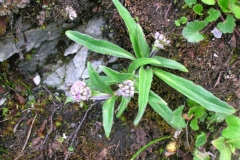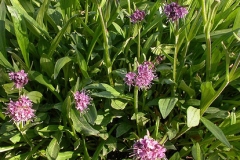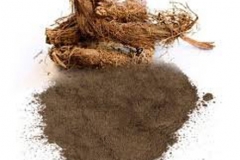Jatamansi (Spikenard) is consisted of two words: Jata which means dread locks and manasi indicates towards human. The root has a look similar to dread locks with a very alcoholic aroma. It is a source of a type of intensely aromatic amber-colored essential oil, spikenard. Rhizomes (underground stems) are crushed and distilled into an intensely aromatic amber-colored essential oil, which is very thick in consistency. Nard oil is used as a perfume, incense, a sedative, and an herbal medicine said to fight insomnia, birth difficulties, and other minor ailments.
Spikenard has been traditionally used in the Ayurvedic system of medicine as a neuro-protective agent for the treatment of hysteria, epilepsy, insomnia, and convulsions. Rhizome of this plant has been considered for its beneficial effect on the nervous system. It is also known to possess an antidepressant activity that helps in the management of psychological disorders like depression, anxiety disorders, mental fatigue, panic disorders, and obsessive-compulsive disorder.
Plant description
Spikenard is actually an erect, hairy, perennial rooted Indian ayurvedic herb that grows about 1 meter (3 ft.) in height. The plant is found growing in woodland garden, sunny edge, cultivated beds, rocks, ledges, and open slopes, alpines, on moist rocky and undisturbed slopes or on stones with coarse sandy loam soils, occurring usually in random forms. Well-drained sandy loam soil is ideal for their proper growth. The soil should contain plenty of organic nitrogen and carbon. Root is long, woody, hairy and stout that is used for oil extraction. Rhizomes are dark brown, tapering, and densely covered with the remains of old leaves’ bases, giving the appearance of a heavy beard. It may be 6–9 cm long with about 20–30- cm-long yellowish taproot. A single root may bear 30–50 rhizomes. Stem is generally pubescent upward, and glabrate below.
Leaves
Leaves are radical as well as cauline. Radical leaves are large 15–22 cm long and 1.5–2.5 cm wide, six to eight in numbers, longitudinally nerved, slightly pubescent, and narrow down into the petiole, while cauline leaves are sessile, occur in two to three pairs, 2.0 cm long and 0.6 cm wide, decrease in size from base to top, and are oblong or sub-ovate in shape.
Flowers & fruit
Flowers are campanulate, pinkish red to bluish white, bell-shaped. Corolla tube is 6 mm long and hairy. Flowering normally takes place from June to august. Later fertilized flowers are replaced by oval fruits that grow somewhere between 1 inches and 3 inches with a sharp apex. Fruit is covered with 4-mm-long hairs and crowned by the acute, often dentate, calyx teeth.
Health benefits of Spikenard
Nardostachys Jatamansi, also known as Jatamansi is a natural tonic good for the brain and nerves. It is a powerful memory enhancer. It is known for the curative and prevention action it produces in the patients suffering from the neurological diseases. Let’s start a discussion on its Ayurvedic medicinal uses and health benefits
1. Dyskinesia & Catalepsy
Spikenard has been commonly used to deal with Dyskinesia and Catalepsy. Dyskinesia is a condition caused due to the difficulty in performing voluntary actions. Catalepsy is characterized by seizures or a trance with the loss of consciousness and sensation. It is usually accompanied by the rigidity of the body. These conditions usually occur due to the side effects of some medications, mainly when they are used for a long term. Spikenard has the ability to reverse the catalepsy and dyskinesia caused due to the chronic use of certain drugs particularly, Reserpine. It prevents the involuntary actions such as the repeated chewing movements, and tongue protrusions. (1)
2. Chronic Fatigue Syndrome (CFS)
Many people with Chronic Fatigue Syndrome (CFS) also suffer from depression and stress. Spikenard root powder along with Ashwagandha is an excellent solution for the management of stress linked CFS. Anti-stress and antioxidant activities of these herbs also help to lower oxidative stress caused by CFS. (2)
3. Memory Loss
Nardostachys Jatamansi helps to improves memory and reduces forgetfulness. It acts as memory restorative agent in people with memory loss. It also has a protective role in stress-induced memory impairments.
According to Ayurveda, it has memory enhancer effects. It improves learning and cognitive functions. It is more beneficial for people with mental stress. If it is used in conjunction with Brahmi, Ashwagandha, Vacha or Shankhpushpi, it provides good results.(3), (4)
4. Insomnia
In appropriate dosage (i.e. 500 mg twice daily), it exerts calming effects and improves quality of sleep and reduces sleeplessness. Along with Tagara and Ashwagandha, it gives good results in the treatment of insomnia.
In Ayurveda, it is not used alone for insomnia; it is used in combination with other herbs for best results. It is much more effective for people awakening with a feeling of un-refreshed or feeling of having the low energy level and with symptoms of irritability, depression, and stress.(5)
5. Depression
De-stressing effects of Nardostachys Jatamansi help to combat depression. It works as an anti-depression agent by inducing a sense of calmness and serenity. Research has discovered that it increases the cerebral levels of a chemical called GABA . It is likely to reduce depression by increasing the levels of monoamines in the brain.
It is considered an effective medicine for depression and used as a drug of choice for its treatment. It mainly offers benefits in depression with aggressive symptoms if it is used alone. It reduces aggressive, self-destructive and violent behaviors. It also reduces restlessness, angry outbursts, frustration, irritability, sleep disturbances, and feeling of lack of energy. It increases vitality and vigor.(6), (7)
6. Heart & Blood Pressure
Spikenard has cardio-protective properties. It works as an excellent cardiac tonic. It boosts the functions of the heart and normalizes the heart rate. It preserves lipid metabolism and prevents oxidative injury to the cardiac tissue. Research has shown that its extract significantly prevent alterations in lipid profile.
In Ayurveda, it is believed to improve blood circulation and normalizes the blood pressure. Its main effect is on blood circulation. It helps in all conditions causing poor circulation in the body. In both Hypertension and Hypo-tension poor circulation is noticeable.(8), (9)
7. Potential to Fight Cancer
Spikenard has been used in traditional medicinal systems to fight cancer. Modern research recommends that it has anti-cancer effects. For instance, one in vitro study found that it promoted cell death and delayed the cell cycle of breast cancer cells. Do speak to your doctor to recognize if Spikenard can be helpful as a supplementary treatment in your fight against cancer.
8. Controls Asthma Attacks
During an asthma attack, the smooth muscle cells in your bronchi tighten and your airways become swollen and inflamed. Animal research shows that Spikenard has a broncho-dilatory effect, helping dilate the bronchi and bronchioles, reducing respiratory airway resistance, and improving airflow to the lungs. The herb extracts also exhibit an antispasmodic effect that controls bronchial spasms that cause these smooth muscles to constrict and narrow your airway. It can help manage asthma.
9. Neuro-protective and hepato-protective
Spikenard consists of two iridoids and compounds that protect the brain from neuronal cell death. Animal research has also shown that pre treatment with spikenard oil helped in the prevention of liver damage and hepato-toxicity when exposed to hepato-toxic compounds.
10. Helps in stress management
Due to its adaptogenic effects on the body, spikenard can help alleviate anxiety and stress. It also functions as a natural sedative by promoting overall relaxation. It is usually used to promote a healthy sleep pattern for people with insomnia.
11. Headache
Spikenard is an effective herb for treating headache described by intense tearing pain around the ears, and eye. It can also help to reduce vertigo accompanying headache. It can relieve the sensation of pressure and tightness across the forehead.
12. Epilepsy & Seizures
Nardostachys Jatamansi appears to offer strong protection against the oxidative stress. This action of the herb makes it an effective agent with strong neuro-protective properties. It can help in maintaining the balance of the hormones in the nervous system and thus prevents seizures in the patients with epilepsy.
13. Aids in diabetes prevention
Scientific Research show that spikenard helps in regulating the glucose levels in the blood and aid in normalizing elevated blood sugar and prevents insulin resistance.
14. Hair fall & Premature Hair Whitening
Spikenard processed in sesame oil is useful for reducing hair fall and preventing premature whitening of hair. Traditionally, it is used for blackening hair and making hair smooth and shiny. It also controls dandruff. Regular use of Spikenard oil results in smooth, silky, voluminous and healthy hair. Internal intake of Nardostachys Jatamansi powder or extract is also helpful in the growth of the hair.
15. Mental Fatigue & Nervine Weakness
Nardostachys Jatamansi acts as a nervine tonic and reduces mental exhaustion. According to Ayurveda, it stimulates the healthy nervine functions and provides nourishment to the brain. Mental Fatigue is also related to mental stress. Its preparations considerably reduce stress and provide a feeling of well-being. It improves cognitive performance, reduces nervine weakness and improves enthusiasm.
500 mg twice daily is sufficient and effective dosage for reducing mental fatigue and inducing relaxation effects in the mind. It is best to take it in low dosage for a longer period instead of using high doses for a short period.
16. Anxiety
Spikenard has anti-anxiety action. It reduces the feeling of restlessness and nervousness, normalizes heart rate, and controls worrying, trembling, trouble sleeping in anxiety, so it is used to control and treat anxiety disorders. It is more effective to control trembling in anxiety disorders.
17. Dysmenorrhea (Painful Periods)
Spikenard has antispasmodic and mild emenagogue actions, which encourages a proper menstrual flow and reduces pain related with menstruation. In dysmenorrhea, its powder should be used in dosage of 500 mg thrice daily with water or its Ark in a dosage of 10 ml twice daily can also be taken. It should be used for a period of 2 to 3 months for a complete relief.
18. Skin diseases
Use of Spikenard can help to improve the skin complexion. It also helps to enhance the health of the skin and prevents the aging signs by promoting regeneration of the skin cells. It can be used to treat the infective disorder of the skin. It provides relief from the burning sensation, swelling, redness, and inflammation that occur due to the skin infections. It is particularly beneficial in treating fungal infections. It produces an anti-fungal action thus relieving the symptoms of these infections.
19. Menopause
Spikenard reduces menopause symptoms like mood swings, sleep disturbance, difficulty in concentrating, memory lapses, headaches, irritability, dizziness, fatigue, stress, anxiety and tingling extremities. In these symptoms, it can help and induces a feeling of general well-being. Spikenard and Saraswatarishta both are quite helpful for controlling the undesired symptoms of menopause.
20. Preventing bacterial infection
Spikenard has a very effective anti-bacterial property. Bacteria have been a root cause for many kinds of health issues such as cholera, food poisoning, septic, tetanus etc. the herb works not only on the skin but also removes it from the very origin. Applying Spikenard on cuts and bruises is a very good way to prevent infections that can be caused due to bacterial activity on those areas. It is also effective in curing infections in the urinary tract and kidneys.
21. Fever with Burning Sensation & Restlessness
In some cases of fever and infections, the patient feels burning sensation, fatigue and restlessness. In these symptoms, Spikenard is highly useful along with Praval Pishti.
22. Intestinal Gas & Abdominal Pain
Spikenard has mild carminative and strong antispasmodic actions, which helps in releasing gas and reducing abdominal pain. In these diseases, it is used along with Cinnamon and Cardamom.
23. Glycosuria (Sugar in Urine)
In Ayurveda, Spikenard is used to reduce the excretion of glucose (sugar) into the urine. Along with Chandraprabha Vati, it improves kidney functions and restores the normal renal threshold. One should take suitable anti-diabetic medicines if elevation in blood glucose is the main cause of sugar in the urine.
24. Treat Pancreatitis
When your pancreas becomes inflamed, it can cause symptoms such as severe abdominal pain, nausea, diarrhea, and vomiting. Research support Spikenard’s potential in fighting both acute and mild pancreatitis. Treatment with this herb was found to reduce not just swelling in the pancreas but also leakage of pancreatic enzymes such as amylase and lipase into the blood, and lung injury associated with pancreatitis. It may even have a protective effect against triggers that could cause pancreatitis.
Traditional uses and benefits of Spikenard
- Root is antispasmodic, carminative, deobstruent, deodorant, diuretic, emenagogue, laxative, nervine, sedative, stimulant and stomachic.
- It is an excellent substitute for valerian, and is taken internally in the treatment of epilepsy, hysteria and convulsive affections, nervous indigestion, insomnia, depression and tension headaches.
- Externally, it is used as a deodorant and to treat rashes.
- Paste of the root is used externally to treat hemorrhoids.
- It helps in reducing the burning sensation, inflammation and pain.
- It lowers the high blood pressure to normal and raises the blood pressure if it is low.
- The herb is known to prevent Atherosclerosis.
- It is useful in treating mental disorders and improves brain functions.
- It is beneficial for sexual debility and impotence.
- It alleviates the symptoms of vertigo and seizures.
- It is effective for urinary problems and maintains the circulatory system.
- It prevents gastritis and bloating.
- It is helpful in neurological disorders like epilepsy, hysteria, convulsions and dizziness.
- It is powerful for respiratory problems.
- It cures hepatitis and liver enlargement.
- It is an aid for menstrual disorders like amenorrhea and promotes mensuration.
- It inhibits cleansing effect on uterus.
- It is used as an antiseptic for skin diseases.
- It relieves from cough and asthma.
- It refines skin texture and complexion.
- It alleviates the problems of digestive tract and treats flatulence, indigestion and constipation.
- Edible roots of these plants are consumed to treat health disorders like epilepsy and hysteria.
- Paste made from Spikenard root and water is used to cure inflammation and burning sensation of skin.
- Root and its oil extraction are used for fighting many skin conditions like allergies and rashes.
- This herb is useful in the treatments of cholera, hepatitis and enlargement of liver.
- Its expectorant properties make it useful to cure cough, cold, asthma and fever.
- This herb is used to increase appetite.
- Spikenard powder along with saffron, turmeric etc. is used to make face pack to improve skin glow.
Ayurvedic Health benefits of Spikenard
- Cough: Powder the Spikenard roots. Add Jaggery in 2:5 ratios. Have it 1/4 teaspoon once a day.
- Epilepsy: Crush the Spikenard roots. Boil half teaspoon powder in a jug of water. Filter it. Take one cup thrice a day.
- Hysteria: Prepare decoction of Spikenard roots. Drink one cup thrice a day. Take it for 2 to 3 weeks.
- Anxiety: Take a cup of Spikenard root decoction, three times a day.
- Headache: Grind the roots. Boil one teaspoon in a jug of water for 10 minutes. Add honey in one teaspoon of this decoction. Take once a day. OR: Boil a pinch of root powder in a cup of water. Drink twice a day. (Attention: It can be taken with milk or honey.)
- High Blood Pressure: Boil one teaspoon powder of Spikenard roots in 10 glasses of water. Have one teaspoon with honey daily. OR make decoction of roots. Add one teaspoon honey. Drink twice or thrice a day.
- Memory Loss: Take one teaspoon decoction of Spikenard roots with equal quantity of honey once a day.
- Analgesic: Grind Spikenard roots with little water. Apply on the affected part.
- Menopausal Symptoms: Grind dried roots of Spikenard to make powder. Take 3 mg of it daily.
- Fatigue: Add 1 ml Spikenard oil in 3 ml Sesame oil. Massage on your body with it.
- Insomnia: Add 3 drops of Spikenard oil in 30 ml warm water. Inhale its steam.
- Blocked Nose: Mix 3 ml Spikenard oil with 1 ml Coconut Oil. Apply it over Chest, Nose and Throat before sleeping.
- Depression: Make a decoction with roots of Spikenard. Drink 30 ml of it twice a day.
- Ascaris: Dry the roots of Spikenard. Crush them to make powder. Take 3 g of it with lukewarm water two times a day.
- Low blood pressure: Soak 50 g Spikenard root in 500 ml water overnight. Drink 10 ml of it thrice a day.
- Baldness: Use Spikenard Oil for massage over Scalp and Hair.
- Amnesia: Consume one pinch of root powder of Spikenard and mix it in one cup of hot water. Drink this mixture for 3 to 4 times a day.
- Migraine: Take Jatamansi Oil and massage your forehead twice a day for at least 2 to 3 weeks to get total relief from Migraine.
- Acid reflux: Crush the roots of Spikenard and prepare a paste and consume with water. It helps in to reduce the burning sensation.
- Asthma: Put 2 drops of Spikenard in the water for steam inhalation. It provides immediate relief from Asthma or other Respiratory Diseases.
- Ulcers: Prepare an ointment from the natural habitat of Spikenard plant. Apply it externally on the infected area.
- Wounds: Make a decoction of Spikenard root. Apply it externally over the infected area to heal the wounds.
- Dry skin: Prepare a paste from root powder of Spikenard with little water and apply it to the skin. It improves the skin texture.
- Insanity: Take 3 g root powder of Spikenard with lukewarm water, two times a day.
- Epilepsy: Take 100 gram root of Spikenard, 5 gram Camphor and 20 gram Cardamom. Powder them. Take a pinch with honey once a day.
- Hysteria: Grind 100 gram root of Spikenard, 5 gram Camphor and 20 gram Cardamom together. Have it a pinch with lukewarm water or honey twice a day.
- Skin Disease: Grind the roots of Spikenard. Mix in Azadirachta Indica oil. Apply on the affected part once a day.
- Baldness: Take oil of Spikenard roots. Mix 10 ml in 100 ml of Coconut oil. Apply on the scalp twice a week.
- Nausea: Boil Spikenard roots in water. Strain. Take one teaspoon with one teaspoon of Lime juice once a day.
- Fever: Take one teaspoon decoction of Spikenard root with one teaspoon of Lime juice.
- Palpitation: Take equal quantity of dried Spikenard roots, Camphor resin and Cinnamon powder. Grind them all. Take half tsp of the powder once a day.
- Hysteria: Add 5 g Indian Snakeroot powder with equal amount of Spikenard root powder. Take quarter tsp of it twice a day.
- Palpitation: Take 60 gm. Spikenard root powder. Add 20 gm. Cinnamon and Camphor powder in it. Take 10 g of the mixture with lukewarm water thrice a day.
- Respiratory Disease: Make an infusion with 16 g Cinnamon, 20 g Camphor powder and 59 g Spikenard root powder. Drink 10 ml of it twice a day.
- Baldness: Take 20 gram Olive Oil, 20 gram Almond Oil, 20 gram Jojoba Oil,10 gram Tea Tree Oil, 10 gram Thyme Oil, 10 gram Patchouli Oil, 20 gram Rosemary Oil and 20 gram Spikenard Oil. Put all oils in a glass bottle. Cover. Leave it for a week. After a week, massage your scalp with this preparation twice a week. It is an effective formula to cure hair problems.
- Libido booster: Take the dried form of 20 gram Cnidium Fruit, 20 gram Chinese Gall, 20 gram Ligusticum Wallichii Root, 20 gram leaves and Stem of Horny Goat Weed, 20 gram Morinda Officinalis Root, 20 gram Cicada Root, 20 gram roots and Rhizomes of Notopterygium, 20 gram Magnolia bark and Flower, 20 gram Galangal Rhizomes, 8 to 10 Garlic Cloves, 30 gram Schisandra Fruit, 10 gram Cinnamon Bark and 30 gram roots and Rhizomes of Spikenard. Powder them together. Have half teaspoon with milk for a few nights. This formula boosts libido, in both men and women. Better results have been found especially in females. It warms up the body and enhances sex stamina.
- Hysteria: Take 3 to 4 tablespoons Spikenard root powder, 2 to 3 tablespoons Sweet Flag powder and 1 tablespoon Black Salt. Mix all the herbs together. Take half tablespoon of this mixture with 1 teaspoon Honey three times a day. Repeat for 2 week to stabilize the Nervous system and cure Hysteria.
- Hyperpigmentation: Mix root powder of Spikenard with Neem Oil. Apply this infusion on affected area to get rid of the disease.
Culinary uses
- Spikenard was used to season foods in Medieval European cuisine, especially as a part of the spice blend used to flavor hypocras, a sweetened and spiced wine drink.
- From the 17th century, it was one of the ingredients for a strong beer called stingo.
- It was a common flavoring in Ancient Roman foods and occurs frequently in the recipes of Apicius, though it tends to be used sparingly.
- Jatamansi powder can be consumed raw with warm water to strengthen the nervous system.
Spikenard Dosage
Jatamansi Root Powder, Jatamansi extract and Jatamansi oil (Spikenard or nard oil) are used for therapeutic purposes. Each formulation has different dosage.
Jatamansi Root Powder Dosage
The general dosage of Jatamansi Churna (Jatamansi Root Powder) is as follows.
Children: 15 to 60 mg per Kg Body Weight
Adults: 1000 mg to 3000 mg
Maximum Possible Dosage: 6 grams Per Day (in divided doses).
Twice a day with an appropriate adjuvant, especially with water
Best Time to Take: 2 Hours after Food, or before sleep.
Root Extract Dosage
The general dosage of Jatamansi Root Extract is as follows.
Children: 4 to 8 mg per Kg Body Weight
Adults: 250 mg to 500 mg
Maximum Possible Dosage: 1500 mg Per Day (in divided doses)
Twice a day with an appropriate adjuvant, especially with water
Best Time to Take: 2 Hours after Food, or before sleep
Decoction Dosage
The general dosage of Jatamansi Decoction is as follows.
Adults: 30 to 60 ml prepared with 10 grams Jatamansi Powder
Maximum Possible Dosage: 120 ml Per Day (in divided doses)
Twice a day
Best Time to Take: 30 minutes before a meal.
Jatamansi Oil Dosage
The general dosage of Jatamansi Oil is as follows.
Adults: 1 to 5 drops
Maximum Possible Dosage: 10 drops Per Day (in divided doses)
Twice a day mixing in a cup of warm water or milk
Best Time to Take: Immediately After Food
Cold Infusion Dosage
Traditional Method: 48 grams of Jatamansi Powder is mixing in 384 grams (ml) cold water and left for overnight or for 12 hours. Then the liquid is strained and taken in the dosage of 96 ml.
Because preparation should be fresh and should be prepared every day, so instead of taking 48 grams Jatamansi Powder, one can use 24 grams Jatamansi Powder and 192 ml cold water and leave it overnight. The liquid obtained in the morning can be used twice a day in a divided dosage of about 96 ml.
Hot Infusion Dosage
Jatamansi Hot Infusion should be prepared from 4 grams of Jatamansi Powder and 240 ml hot water. The mixture of hot water and Jatamansi should be left overnight covering the vessel with a lid and filtered in the morning. The same procedure should be followed for evening dosage.
Other facts
- Essential oil is obtained from the root and young stems.
- It is harvested before the leaves unfurl.
- It is used in perfumery and as a hair tonic where it is said to make the hair grow faster and also to turn it black.
- Dried leaves are used as an incense.
- It is widely used by Tibetans for making healing incenses.
- Spikenard oil is used in aromatherapy.
- It is used for manufacturing soaps, body fragrances, skin lotions, bath oils and other cosmetic products.
- Spikenard root is considered to be the “forbidden fruit” from the Garden of Eden by some people.
- It is said that Mary Magdalene used the essential oil of this herbal plant for anointing Jesus’ feet before last supper.
- Plants raised through seeds may take three to four years to mature, while the plants raised through splitting of rhizomes mature in two to three years and are ready for harvesting earlier.
Side Effects of Spikenard
Allergic Reactions
People suffering from hypersensitivity to any of the chemical constituents of Nardostachys Jatamansi should avoid using this herb. An allergic reaction to this herb may cause a difficulty in breathing, skin rashes, itching and difficulty in swallowing.
Pregnancy & Breastfeeding
Spikenard is an emenagogue, so it promotes menstrual discharge. Its higher dosage (more than 2000 mg powder) may result in spotting or bleeding in pregnancy. Pregnant and breastfeeding women should avoid the use of this herb. Its extract should be absolutely avoided during pregnancy and lactation.
References:
https://pfaf.org/user/Plant.aspx?LatinName=Nardostachys+grandiflora
http://www.theplantlist.org/tpl1.1/record/kew-2382349
https://en.wikipedia.org/wiki/Spikenard
https://en.wikipedia.org/wiki/Nardostachys_jatamansi
http://www.orientjchem.org/vol32no2/medicinal-properties-of-nardostachys-jatamansi-a-review/
https://indiabiodiversity.org/species/show/252332
Comments
| Spikenard Quick Facts | |
|---|---|
| Name: | Spikenard |
| Scientific Name: | Nardostachys jatamansi |
| Origin | India, China, Nepal and Bhutan |
| Shapes | Oval fruits grow somewhere between 1 inches and 3 inches with a sharp apex |
| Taste | Sweet, bitter, acrid, astringent |
| Health benefits | Treat Pancreatitis, Glycosuria, Intestinal Gas & Abdominal Pain, Fever with Burning Sensation & Restlessness, Prevent bacterial infection, Menopause, Skin diseases, Dysmenorrhea , Anxiety, Mental Fatigue , Hair fall & Premature Hair Whitening, Aids in diabetes prevention, Epilepsy & Seizures, Headache, stress management, Neuro-protective and hepato-protective, Controls Asthma Attacks, Fight Cancer,Heart & Blood Pressure, Depression, Insomnia , Memory Loss, Chronic Fatigue Syndrome , Dyskinesia & Catalepsy |
| Name | Spikenard |
|---|---|
| Scientific Name | Nardostachys jatamansi |
| Native | India, China, Nepal and Bhutan |
| Common Names | Indian nard, Indian spikenard, Nard, spikenard, musk root, valeman, nardin, balchar, sumbul-ut-teeb, sambul lateeb, Jatamansi, jatamashi |
| Name in Other Languages | Bengali: Bal-Chur, Masi Chinese: Gan song English: Indian nard, Indian spikenard, Nard, spikenard, musk root, valeman German: Nardenähre, Speichenähre Gujarati: Jatamansi Hindi: Jatamasi, balchadi Kannada: Jatamansi Kashmiri: Bhuyijatt Marathi: Jatamansi Malayalam: Jatamansi Sanskrit: Tapasvini, Vilomasa, Bhutajata, Jatamansi, Nalanda Tamil: Jatamansi Telegu: Jatamansi Unani: Sumbul-ut-teeb |
| Plant Growth Habit | Erect, hairy, perennial rooted Indian Ayurvedic herb |
| Growing Climates | Woodland Garden, Sunny Edge, Cultivated Beds, Rocks, ledges, open slopes, alpines, on moist rocky and undisturbed slopes or on stones with coarse sandy loam soils, occurring usually in random forms |
| Soil | Well-drained sandy loam soil is ideal for their proper growth. The soil should contain plenty of organic nitrogen and carbon |
| Plant Size | About 1 meter (3 ft) in height |
| Root | Long, woody, hairy and stout roots that are used for oil extraction |
| Rhizomes | Dark brown, tapering, and densely covered with the remains of old leaves’ bases, giving the appearance of a heavy beard. It may be 6–9 cm long with about 20–30- cm-long yellowish taproot. A single root may bear 30–50 rhizomes |
| Stem | Generally pubescent upward, and glabrate below |
| Leaf | Long leaves grow surrounding one single flower stalk (sessile leaves). Their average length is somewhere between 15 cm and 20 cm. The breadth of these leaves varies from 1.5 cm to 2 cm. |
| Flowering season | June to august |
| Flower | Campanulate, pinkish red to bluish white, bell-shaped flowers. Corolla tube is 6 mm long and hairy |
| Fruiting | September to October |
| Fruit Shape & size | Oval fruits grow somewhere between 1 inches and 3 inches with a sharp apex. Fruit is covered with 4-mm-long hairs and crowned by the acute, often dentate, ca- lyx teeth |
| Pollination | Honey bees and wind |
| Flavor/aroma | Woody, spicy, musty |
| Taste | Sweet, bitter, acrid, astringent |
| Plant Parts Used | Root, rhizome, jatamansi oil, seeds, fruits |
| Available Forms | Dried root, oil, powder, capsule and infusions |
| Propagation | Root cuttings and from seeds |
| Season | August and October |
| Health Benefits |
|
| Precautions |
|


